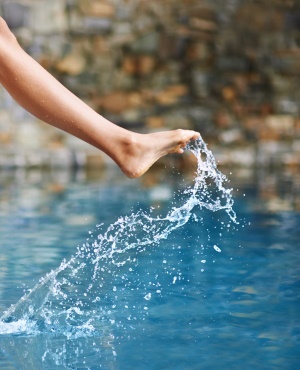
As the water crisis in Cape Town grows more dire, many have been left with ever decreasing water levels in their swimming pools.
Last year Capetonians could still fill their pools with municipality water, as long as they used a pool cover. But that was before the city endured below average winter rainfall causing even more water restrictions. Capetonians have been called on to save water by any and all means possible.
The city has also gone to great lengths to clarify the situation for residents who are still unsure about their pools and municipal water (or tap water).
“No filling (automatic or by hand) of private swimming pools with municipal water is allowed, even if the pool is covered. This includes the filling of new swimming pools and the refilling of existing swimming pools after repair work. The use of municipal water for portable swimming pools is also prohibited.
So should swimming pool owners in Cape Town and other areas affected by the drought simply forget about their source of summer pleasure – in which many have invested large sums of money?
What do you do with your swimming pool in this situation? Despite what authorities are calling the “new normal” of climate change – less rainfall and warmer weather – people can still aim for a “water neutral” swimming pool, suggests the National Spa & Pool Institute of Southern Africa (NSPI).
According to the industry authority a “water-wise” swimming pool doesn’t have to be dependent on municipal water sources.
And in the drought-stricken region it’s still totally possible to keep your swimming pool running without the use of municipal water, they assure readers.
Their three step programme includes the storing of rain water, the use of the proper pool cover as well as the recycling of water (when you clean the filter system).
Water for later: Anyone who wants to run a water neutral pool needs to make use of a water storage tank for rain water, for example.
A 2 500 litre tank for a smallish swimming pool of about 25 000 litres and 5 000 litre tank for a large swimming pool of about 60 000 litres should suffice. The tank’s pipe system should make it easy to use the water to fill the swimming pool as well as for other uses when you’re not using your pool. The water in the tank should also be maintained at the same standard as the water in the swimming pool.
Pool cover, pool cover: With a light pool cover or thermal blanket you can almost put a total stop to water evaporating from your pool. An estimated 90-97% of evaporation can be avoided.
Put differently, if you protect your pool with a cover the water level will only drop by about 0,5cm every week – as oppose to 5cm a week without a cover.
The water under a pool cover, which keeps out dirt, will also be totally fine if you only circulate it for about two to three hours per day and only put in a small amount of chlorine. That way you also save on energy and chemicals.
Other ways: If you don’t want to opt for pool covers and storage of rain water you can fill your pool with water from your borehole.
But then you need to ensure the groundwater is suitable to use in your pool. Too much iron in the water can, for example, cause problems. The water would need to be treated.
Various services have since appeared online where groundwater and non-municipal water can be bought (and transported by trucks) for use in swimming pools. Make sure your supplier’s business practices are sound and make sure the water is suitable for use in your swimming pool.
Don’t let it stand empty and untreated: An empty swimming pool can start to crack and the entire structure can start to move upwards because the water is no longer keeping it in place.
Stagnant, untreated water can also attract microbes which can pose a serious health risk.
If you want to get rid of it: It’s far easier to get rid of a swimming pool with fibreglass walls. The shell is cut with angle grinders and the hole is then filled with earth. A spray cement swimming pool takes a bit more work to remove: after the water is pumped out holes need to be made in the cement structure before the holes are filled with sand.
If that’s not done the hidden cement can cause a sort of swamp to occur when the rainy months come and water can’t be properly absorbed into the earth.
Sources: capetown.gov.za, nspi.co.za, westerncape.gov.za, capetalk.co.za, capetowngreenmap.co.za




 Publications
Publications
 Partners
Partners
















